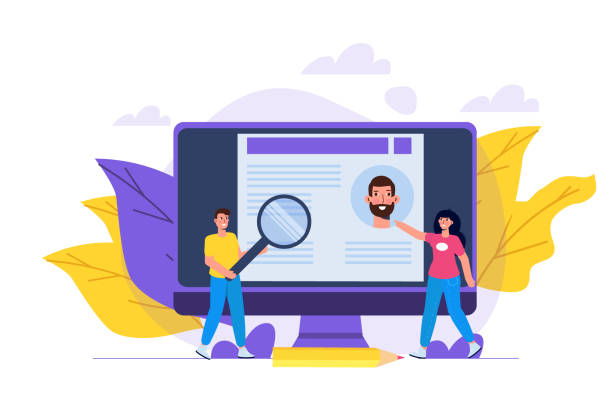An Introduction to SEO-Optimized Website Design: A Necessity for Survival in the Digital World

In the current era, where the internet has become an inseparable part of daily life, having a website is essential for every business.
However, merely having a website is not enough; your website must be seen.
This is where the concept of SEO-optimized website design becomes important.
SEO, or Search Engine Optimization, is a process that prepares your website to achieve a better ranking in the search results of Google, Bing, and other search engines.
This is an ongoing educational process that requires a deep understanding of search engine algorithms and user behavior.
Without proper design, even the best content may never reach its target audience.
The primary goal of SEO is to increase organic website traffic; traffic that comes from user searches and usually has a much higher quality than traffic from paid advertising.
SEO-optimized website design from the outset optimizes the website structure, content, loading speed, and user experience in a way that is understandable for search engines and appealing and practical for users.
This proactive approach is far more effective and cost-efficient than trying to SEO an already designed website, which might require deep structural changes.
In fact, investing in this type of design is a long-term investment for your online success.
Ignoring SEO in the design process can lead to wasted resources and countless lost opportunities in the competitive digital market.
This is the foundation of any successful digital marketing strategy.
Are you aware that poor online store design can drive away up to 70% of your potential customers? RasaWeb transforms your sales with professional and user-friendly e-commerce website designs.
✅ Significant increase in sales and revenue
✅ Full optimization for search engines and mobile
⚡ [Get Free Consultation from RasaWeb]
Key Elements in SEO-Optimized Website Design
![]()
To have an effective SEO-optimized website design, it is necessary to pay special attention to several key elements.
These elements include technical, content, and user experience factors, all of which must work in harmony.
The first and perhaps most important element is the technical structure of the website.
A website must have clean and optimized code so that search engine crawlers can easily index it.
This includes the use of semantic HTML, friendly URLs, and an XML Sitemap.
The second crucial element is site loading speed.
Today’s users are impatient, and if your site loads slowly, they will leave it.
Google also considers speed as an important ranking factor.
Optimizing images, using a CDN, and reducing HTTP requests can help improve speed.
This section provides practical guidance and expert tips.
Tools like Google PageSpeed Insights can help you identify speed issues.
Furthermore, website mobile-friendliness is of high importance.
Given the significant increase in mobile internet usage, your website must display well on various devices and provide a consistent user experience.
Responsive Design is the best solution for this purpose.
Also, website security using an SSL certificate (HTTPS) is a requirement.
Google prefers secure websites, and this also helps increase user trust.
High-quality and relevant content, proper use of keywords, and creating a smooth user experience are other important elements that will be discussed in detail in later chapters.
Together, these elements form the foundation of a successful SEO-optimized website design.
Keyword Research and Content Strategy in SEO-Optimized Website Design
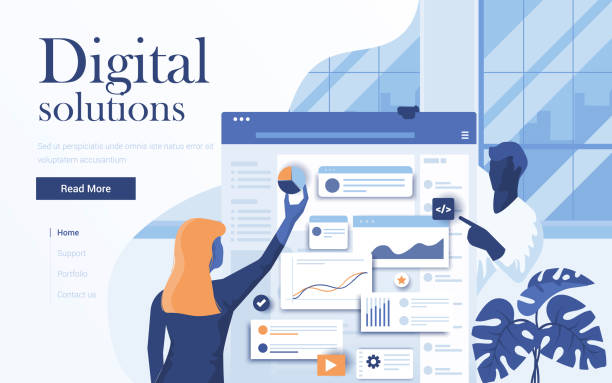
Keyword research is the backbone of any SEO strategy and an inseparable part of SEO-optimized website design.
This process involves identifying the phrases and words your target audience uses to find your products or services in search engines.
Comprehensive keyword research helps you create content that is both appealing to users and easily indexed by search engines.
This stage is, in fact, an expert and highly crucial step that determines the entire direction of your content strategy.
Without this step, you might produce content that no one searches for, or in other words, waste your time and energy.
After identifying primary and secondary keywords, it’s time for content strategy.
Content must be high-quality, informative, unique, and valuable.
Duplicate or low-value content not only doesn’t help your SEO but can also harm your ranking.
Use various types of content such as blog articles, service pages, product pages, videos, infographics, and case studies to cover different user needs.
When producing content, pay attention to Keyword Density, but never sacrifice content quality for it.
Natural and logical use of keywords is far more important than over-repetition.
To organize keywords and related content, a table structure can be used, as provided below.
| Primary Keyword | Secondary Keywords | Suggested Content Type | Content Goal |
|---|---|---|---|
| SEO-optimized website design | website optimization, website SEO, professional website creation | Comprehensive blog article, service page | Information dissemination, customer acquisition |
| SEO tools | Search Console, Google Analytics, Ahrefs | Educational article, tool review | Practical training, skill improvement |
| Link building | backlink, internal link, external link | Step-by-step guide, case study | Providing solutions, proving expertise |
This table helps you better manage your content roadmap and ensure that each piece of content is correctly targeted.
Technical Aspects of SEO in SEO-Centric Website Design
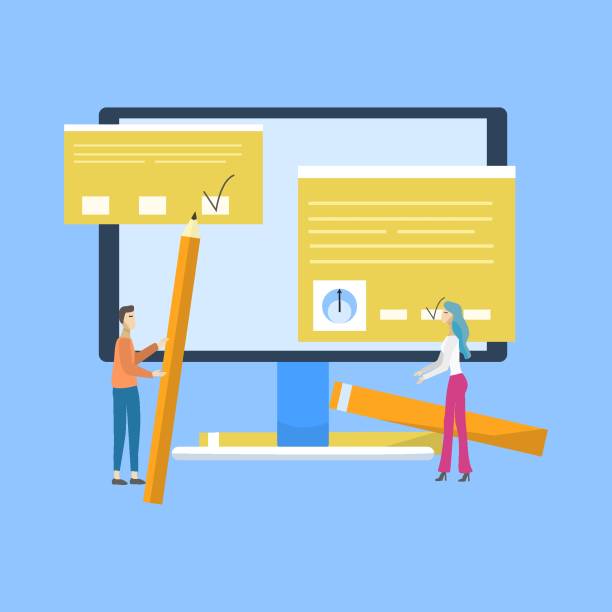
Technical aspects of SEO form a crucial part of SEO-centric website design that are often overlooked but are vital for site visibility in search engines.
This technical section deals with the website’s backend structure and ensures that search engines can easily crawl, understand, and index your content.
The first factor is an optimized URL structure.
Short, descriptive, and keyword-rich URLs not only help SEO but are also more readable for users.
Avoid unnecessary characters and long identifiers.
Website design with an SEO approach also requires a logical and hierarchical site structure.
Pages should be logically linked to each other, so that users and search engine crawlers can easily navigate the site.
This also helps distribute “Link Equity” throughout the site.
Proper use of Title Tags and Meta Descriptions for each page is very important.
These tags are the first thing users see in search results and play a key role in Click-Through Rate (CTR).
Ensure that these tags contain relevant keywords and concisely summarize the page’s content in an appealing way.
An XML Sitemap is a file that introduces all important pages and content of your website to search engines and helps them discover and index your site more comprehensively.
Also, the robots.txt file tells search engines which parts of your site to crawl and which to ignore.
Proper management of these files is of paramount importance.
Image optimization (using descriptive Alt Text and compression) and enabling HTTPS are also other vital technical aspects for SEO-optimized website design.
Are you bothered by losing customers because of your e-commerce site’s outdated look or slow speed? RasaWeb’s expert team solves these problems with professional e-commerce website design!
✅ Significantly increase customer trust and brand credibility
✅ Blazing fast speed and excellent user experience
Get a free consultation with RasaWeb right now ⚡
User Experience (UX) and Its Impact on SEO-Optimized Website Design
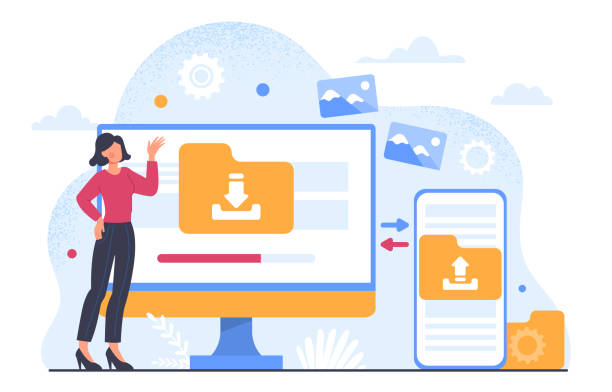
User Experience (UX) is no longer a peripheral factor in SEO, but has become one of the most important ranking factors in SEO-optimized website design.
Google and other search engines are increasingly focusing on user satisfaction, and websites that provide a better user experience generally achieve higher rankings in search results.
This analytical approach indicates that search engines have matured and no longer rely solely on keywords, but also value user interactions.
Factors such as low Bounce Rate, high Dwell Time, and the number of pages visited per session are all positive signals for search engines, indicating that your content is valuable and engaging.
To improve user experience and consequently website SEO, several key points must be considered.
Attractive and user-friendly visual design is one of the most important.
Your site should be easy to navigate, and users should be able to quickly find the information they need.
Using clear menus, prominent Call-to-Action (CTA) buttons, and logical visual layouts all contribute to this.
Content readability is also very important.
Using appropriate fonts, sufficient font size, short paragraphs, subheadings, and lists makes your content more readable and encourages users to stay on the page.
Core Web Vitals are a set of metrics from Google that measure the quality of user experience in terms of loading speed, interactivity, and visual stability.
Optimizing for these metrics directly impacts your site’s SEO.
Finally, website responsiveness across different devices (mobile, tablet, desktop) and ensuring a consistent user experience across all platforms is of paramount importance.
A true SEO-optimized website design simultaneously satisfies search engines and captivates users.
Link Building Strategies for Website Optimization

Link Building is one of the most powerful strategies for website optimization and increasing its authority in the eyes of search engines.
Links act as “votes of confidence” from one website to another, indicating that your content is valuable and authoritative.
The more high-quality and relevant links pointing to your site, the higher your Domain Authority will be, which in turn helps improve your SEO ranking.
This is an expert and complex aspect of SEO that requires patience and correct strategy.
Website design with an SEO approach should consider the potential for link building from the start.
There are different types of links.
Internal Links are links that connect different pages of your own website to each other.
These links help search engines understand your site’s structure and distribute link authority throughout the site.
External Links or Backlinks are links from other websites to your site.
These are the most important type of links for SEO.
To acquire high-quality backlinks, you can use various strategies, such as creating extremely high-quality content that is naturally linked to by others (Content Marketing), guest posting on relevant blogs, broken link building, and collaborating with influencers.
But more important than quantity is the quality of the links.
A backlink from a reputable and relevant website is far more valuable than dozens of backlinks from spammy or irrelevant sites.
Avoiding illicit link-building methods (Black Hat SEO) is very important, as it can lead to your site being penalized by Google.
A SEO-optimized website design never relies on illicit methods.
Measuring Success and Data Analysis in SEO-Optimized Website Design
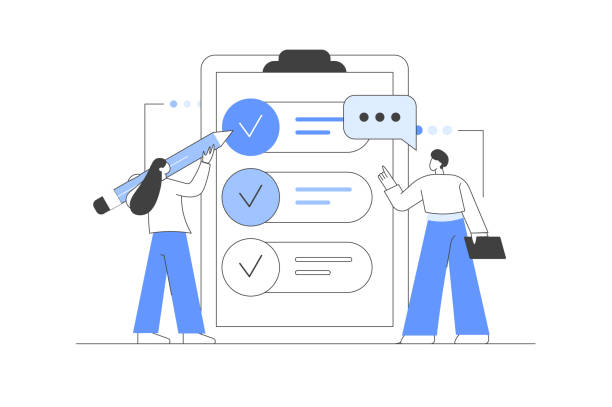
After implementing an SEO-optimized website design, the next stage is measuring success and data analysis.
This analytical process allows you to evaluate the effectiveness of your SEO strategies and identify strengths and weaknesses.
Without measurement, you will never know what works and what needs improvement.
Various tools exist for this purpose, each providing valuable information.
The most important tools are Google Analytics and Google Search Console.
Google Analytics provides you with precise information about website traffic, user behavior, conversion rates, and other important metrics.
You can see where users come from (organic search, social media, direct links, etc.), how long they stay on the site, which pages they visit, and what actions they take.
This data helps you gain a deeper understanding of your audience and optimize your site’s content and structure based on their needs.
Access Google Analytics.
Google Search Console is a vital tool for monitoring your website’s SEO performance in search results.
This tool shows you for which keywords your site ranks in Google, how many times it has appeared in search results (Impressions), and how many clicks it has received (Clicks).
It also reports technical issues such as Crawl Errors, security problems, and HTML improvements.
This information helps you quickly identify and fix problems and improve your SEO ranking.
| SEO Metric | Description | Measurement Tool | Importance |
|---|---|---|---|
| Organic Traffic | Visitors through search engines | Google Analytics | Indicates overall SEO success |
| Keyword Ranking | Site’s position for specific phrases | Google Search Console, Rank Tracking Tools | Indicates search visibility |
| Click-Through Rate (CTR) | Percentage of clicks based on impressions in results | Google Search Console | Attractiveness of title and meta descriptions |
| Bounce Rate | Percentage of users who visit only one page and leave | Google Analytics | Quality of user experience and content |
By continuously monitoring these metrics, you can optimize your SEO campaign and get the best results from your SEO-optimized website design.
Common Mistakes in Building an SEO-Optimized Website and Ways to Prevent Them

Even with the best intentions, you might make mistakes in the process of building an SEO-optimized website that can harm your SEO ranking.
Understanding these common mistakes and ways to prevent them is an important part of the educational and guidance process for every webmaster.
One of the biggest mistakes is ignoring keyword research.
Without it, you might rank for keywords that no one searches for, or try to rank for highly competitive keywords without a chance of success.
This is the questionable content that explains why some websites, despite their visual appeal, are not seen.
The solution is to always conduct comprehensive keyword research before producing content.
Another mistake is producing low-quality or duplicate content.
Google rewards original and valuable content.
Duplicate Content or content with little added value can harm your ranking.
Always focus on quality, not quantity.
Also, filling pages with keywords (Keyword Stuffing) is an old and harmful practice that is penalized by Google.
Prioritize natural and logical use of keywords.
Ignoring technical SEO is also a major error.
Technical issues such as slow site speed, lack of mobile-friendliness, improper URL structure, and crawl errors can nullify your SEO efforts.
Always optimize your website technically.
Finally, ignoring user experience (UX) is a mistake that directly impacts your SEO.
Websites that are difficult to navigate, have cluttered designs, or unreadable content lead to high bounce rates and low user retention.
Ensure your site is appealing and functional for users.
Avoiding these mistakes is the foundation of a successful and sustainable SEO-optimized website design that protects you from search engine penalties and contributes to continuous growth.
Are you tired of your e-commerce site getting visitors but no sales? RasaWeb solves your main problem with professional e-commerce website design!
✅ Significantly increase sales with targeted design
✅ Flawless user experience for your customers
⚡ Get a free consultation right now!
Future Trends in SEO and SEO-Centric Website Design
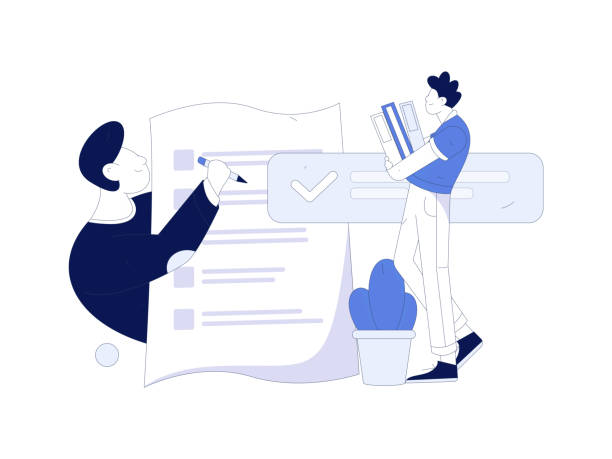
The world of SEO is constantly changing, and to succeed in SEO-centric website design, one must keep pace with future trends.
This news and analytical section helps you look at what to expect in the future of SEO and website optimization.
One of the most important trends is the increasing focus on Voice Search.
With the proliferation of voice assistants like Siri, Alexa, and Google Assistant, users are searching more than ever through voice commands.
This type of search is usually longer and more conversational, so your content must be optimized to answer these types of questions.
Consequently, focusing on Long-Tail Keywords and direct answers to questions becomes more important.
Artificial Intelligence (AI) and Machine Learning play a more prominent role in search engine algorithms.
With algorithms like RankBrain and BERT, Google is better able to understand the meaning of words and the intent of user searches.
This means that simply repeating keywords is no longer enough; your content must genuinely answer user questions and provide real value.
Creating comprehensive, accurate, and high-quality content that answers various user questions will become even more crucial.
Google’s guidance on AI-generated content emphasizes quality and originality.
Also, the importance of Local SEO continues to grow for local businesses.
Optimizing for Google My Business and ensuring the consistency of NAP (Name, Address, Phone) information across the web is essential for visibility in local searches.
A more comprehensive and richer user experience, including the use of video and interactive content, is also among future trends.
Your website should be appealing and functional not only for search engines but also for the new generation of users.
Following these trends and incorporating them into your SEO-optimized website design strategy will keep you ahead in the competition.
The Importance of Continuous Updates and Maintenance for SEO-Approach Website Design
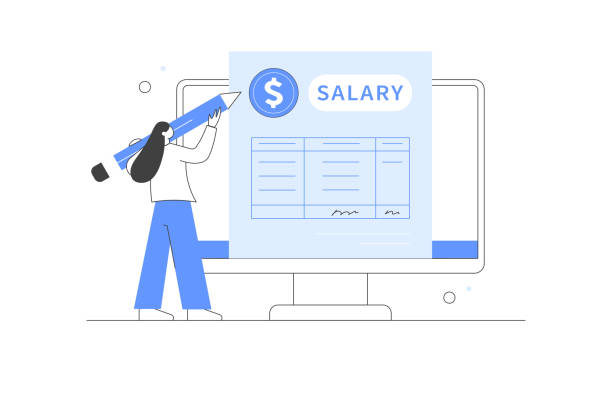
SEO-approach website design is not a one-time process, but requires continuous updates and regular maintenance.
The digital world is rapidly changing; search engine algorithms evolve, competitors adopt new strategies, and new technologies emerge.
Therefore, a dynamic and continuous approach to SEO is vital for maintaining and improving your ranking.
This explanatory section discusses the importance of this sustained process.
One of the main reasons for continuous updates is Google algorithm changes.
Google updates its algorithms multiple times a year, some minor and some major.
If your site does not keep pace with these changes, it may lose its rankings.
Therefore, awareness of the latest updates and applying necessary changes is essential.
Technical site maintenance is also of paramount importance.
Checking for broken links, fixing 404 errors, updating CMS software (like WordPress) and plugins, and monitoring site speed are all part of this maintenance.
These actions not only help SEO but also improve user experience.
Your site’s content should also be updated regularly.
Outdated content may contain obsolete information or no longer answer user questions.
Adding new information, updating statistics and figures, and expanding existing content all signal to search engines that your site is active and relevant.
This also encourages users to return to your site for new information.
Monitoring competitors and analyzing their strategies is also part of this continuous maintenance.
By observing what competitors are doing, you can identify new opportunities and adjust your strategies to surpass them.
Ignoring these aspects will gradually lead to a decrease in your site’s visibility in search results.
Therefore, investing time and resources in continuous maintenance and updating of your SEO-optimized website design is a smart step for long-term success in the online space.
Frequently Asked Questions
| Question | Answer |
|---|---|
| What is SEO-optimized website design? | SEO-optimized website design means designing and coding a website that is technically, content-wise, and structurally optimized so that search engines can easily crawl, index, and assign a higher ranking to it in search results. |
| Why is SEO-optimized website design important? | Its importance lies in increasing website visibility in search engine results (like Google), attracting more organic traffic, improving user experience, and ultimately increasing conversion rates (sales or desired actions). |
| What are the most important technical SEO factors in website design? | High loading speed, responsiveness (Mobile-Friendly), proper URL structure, use of SSL certificate (HTTPS), XML sitemap, and robots.txt file. |
| What impact does Responsive Design have on SEO? | Since most searches are done via mobile, Google prioritizes responsive sites. Responsive design improves user experience and reduces bounce rate, both of which help SEO. |
| How does site loading speed affect SEO? | Loading speed is an important ranking factor for Google. Slow sites lead to poor user experience, increased bounce rate, and lower rankings in search results. |
| What is the role of URL structure in SEO? | Short, readable URLs that contain relevant keywords help both users and search engines better understand the page’s topic, which positively impacts SEO. |
| What is the importance of using Title Tags and Meta Descriptions in SEO design? | These tags provide information about the page’s content to search engines and users. Optimizing them with appropriate keywords increases Click-Through Rate (CTR) and improves content understanding by search bots. |
| What is the importance of Image Optimization in SEO? | Reducing image size to increase site speed, using descriptive Alt Text (including keywords) to describe the image to search engines, and increasing the chance of appearance in Google Image Search. |
| How does Internal Linking help SEO? | Internal linking helps search engines better understand the site structure, distributes authority (PageRank) throughout the site, and directs users to relevant pages, which improves user experience and reduces bounce rate. |
| What is the relationship between User Experience (UX) and SEO? | Google values sites that provide a good user experience. Attractive visual design, easy navigation, readable content, and high speed all contribute to improved UX, which in turn leads to lower bounce rates, increased time spent on site, and positive signals to search engines. |
And other services of RasaWeb Advertising Agency in the field of advertising
Smart Direct Marketing: A creative platform for improving digital branding with customized user experience.
Smart Advertising Campaign: An exclusive service for growth analyzing customer behavior based on key page optimization.
Smart Customer Journey Map: Transform website traffic growth by optimizing key pages.
Smart Customer Journey Map: Professional optimization to increase click-through rates using Google Ads management.
Smart Digital Branding: Designed for businesses seeking user engagement through attractive UI design.
And over hundreds of other services in the field of internet advertising, advertising consultation, and organizational solutions
Internet Advertising | Advertising Strategy | Advertorials
Sources
Comprehensive SEO Checklist for Your WebsiteSEO Training for Beginners: Step-by-StepThe Role of Content Marketing in SEO and Traffic Increase10 Important Tips for SEO-Centric Website Design
? RasaWeb Afarin Digital Marketing Agency is your companion and guide on the challenging path of the digital world. By providing services such as website design with modern UI, professional SEO, and specialized content production, we elevate your business and establish a powerful online presence for you.
📍 Tehran, Mirdamad Street, Next to Central Bank, Southern Kazeroun Alley, Ramin Alley, No. 6



